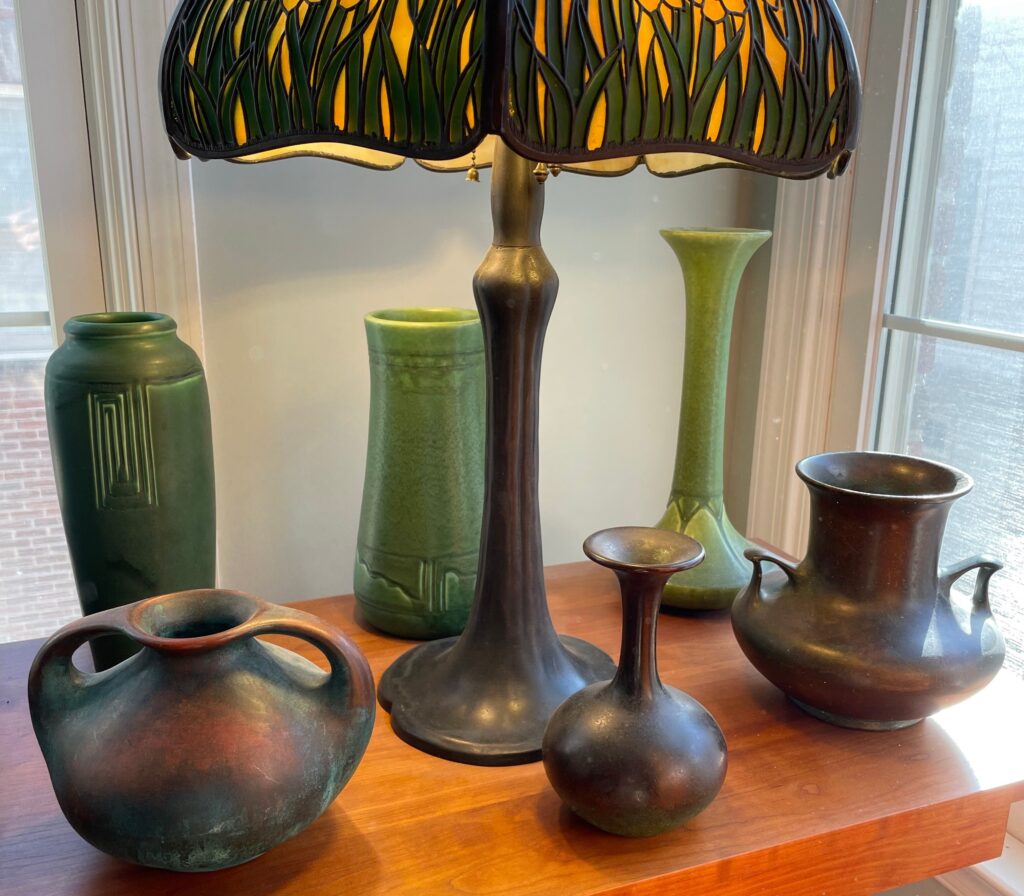Rookwood Marks
Rookwood’s excellent marking conventions are a boon to collectors, buyers and sellers. Aside from the aesthetic appeal of the pottery, the clear, understandable and informative markings certainly make identifying, understanding and collecting Rookwood pottery easier and more fun.
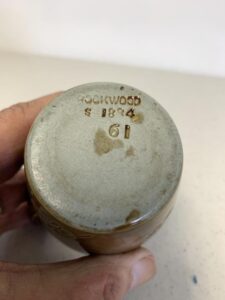
From 1882 to 1886, “ROOKWOOD” in block letters and the year made were impressed on the bottom of Rookwood pieces.

In 1886, the company adopted the conjoined letters RP as its logo, stamped on the bottom of each piece. A flame was added around the logo each year to mark the date the piece was produced. Pre-1900 pieces may be dated by counting the flames. In 1901, the company began incising Roman numerals which made dating easy.
Rookwood pieces are also marked with an impressed shape number on the bottom below the logo and date. The Second Book of Rookwood Pottery by Herbert Peck contains a full numerical listing of the more than 4,000 shapes, accompanied by sketches and identifying information. Factory misnumbered items are rare but do crop up from time to time. Search this site for “factory misnumber” to see examples.
Many Rookwood pieces have an artist’s mark, or cipher, on the base. These are either incised in the pottery or inked under the glaze. Identifying them is important when valuing Rookwood pieces since certain Rookwood artists have a loyal following, increasing the value of their pieces. A distinction should be drawn between individually artist-signed pieces and pieces in which the designer’s cipher has been incorporated into the mold. (Peck II, p.33; see, e.g., shape 2275(6).)
If you want to see examples of the cipher of a particular artist, just put the artist’s name into the search box.
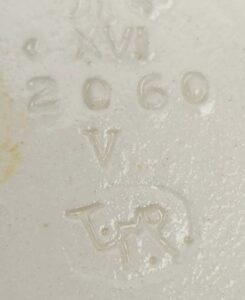
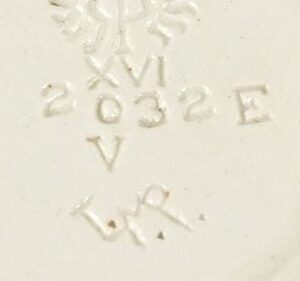 The artist’s cipher shown at left, which has surfaced on pots made in 1916, is unidentified. Any information about the identity of this artist would be appreciated.
The artist’s cipher shown at left, which has surfaced on pots made in 1916, is unidentified. Any information about the identity of this artist would be appreciated.
Letters are often also impressed on the bottom, adjacent to the shape number. These letters impart useful information:
The letter “V” was impressed in the base to denote vellum glaze, a transparent mat glaze introduced in 1904 which enjoys enduring popularity. See History page on this site. Not all vellum glaze pieces bear the “V” marking, however.
Impressed letters from “A” to “F” denote the size of the piece, with A being largest and F being smallest. Sizes are not standardized, however, so size C of one shape is not necessarily the same as size C of another shape.
Sometimes letters are impressed or scored on the bottom of pieces to indicate the color of clay used. These include “W” for white (on which Iris glaze was used), R for red (on which Mahogany glaze was used).
“G” was inscribed for Sea Green glaze. A sideways “P” denotes a glaze called “Soft Porcelain.” (Peck II, p.23.)
Architectural faience pieces were assigned numbers starting from 1100. These pieces bear the letter “Y.” (See shapes 1114(2), 1116.)
Mat glaze was introduced around 1900 and such pieces bore the letter “Z” after the shape number. In 1904, however, this line was renumbered from 912-1142 and the “Z” dropped. (See History.) Where possible such items are identified by both the original and successor numbers on this website. (For example, see shape number 120Z.) The Second Book of Rookwood Pottery lists Z-line pieces under the successor shape numbers.
Finisher’s marks are sometimes found in the form of dots. Small arrows, triangles and crosses also occasionally appear; these are likely also finisher’s marks but that has not been definitively established.
Rookwood Pieces Marked “S” or Unnumbered
The letter “S” was used to identify a special piece, not part of the regular line. When the letter S precedes a shape number, it indicates the piece was made directly from a sketch or drawing and was not the shape usually corresponding to that number.
When the S appears without a shape number, it denotes that the piece was made for demonstration, often prompted by important visitors to the pottery. (Herbert Peck, The Book of Rookwood Pottery, p.137.) Many such pieces were produced in the lean years of the Depression, decorated by Kataro Shirayamadani. See, for example, shapes S(2), S(17), S(69).
In this database, pieces marked “S” appear under the shape number if present; if not they are found at the beginning of the listings under “S.” Also, pieces having neither shape number nor “S” (rarely found) are indexed as “U” items. If you want to search for a particular “S” or unnumbered item, put the year it was made or the artist’s name in the search box. “S” and “U” items will appear first in the search results.
Rookwood 50-Year Anniversary Marking
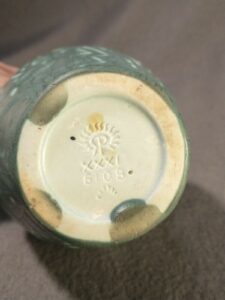
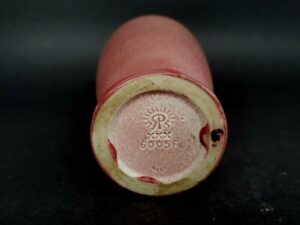
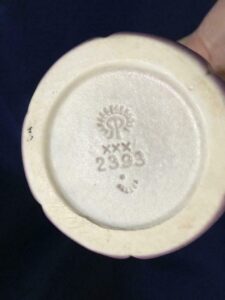
As shown in the above examples, some (but not all) pieces produced in 1930 and 1931 bear a special 50-year anniversary supplemental marking consisting of a semicircular set of hash marks, usually incised below the shape number.
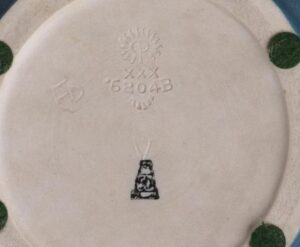 A special firing of 1,200 pieces was done to commemorate the 50th anniversary; those pieces bear a printed image of a kiln with the number “50” inside. (See photo at right and, e.g., shapes 2818, 6185(4), 6200(3), 6204(2), 6022(7); 6196(2).) The kiln image also appears on special firings in 1940 and 1941 with the number 61 (commemorating the company’s emergence from bankruptcy) (shapes 951(16), 6218(4), 6701(2), 6768(3)), in 1950 with the number 70 (shapes 6591(5), 6933), and in 1955 with the number 75 (shape 6920(3)).
A special firing of 1,200 pieces was done to commemorate the 50th anniversary; those pieces bear a printed image of a kiln with the number “50” inside. (See photo at right and, e.g., shapes 2818, 6185(4), 6200(3), 6204(2), 6022(7); 6196(2).) The kiln image also appears on special firings in 1940 and 1941 with the number 61 (commemorating the company’s emergence from bankruptcy) (shapes 951(16), 6218(4), 6701(2), 6768(3)), in 1950 with the number 70 (shapes 6591(5), 6933), and in 1955 with the number 75 (shape 6920(3)).
Rookwood Pieces Marked “X”
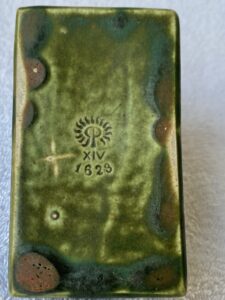
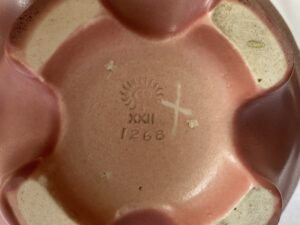
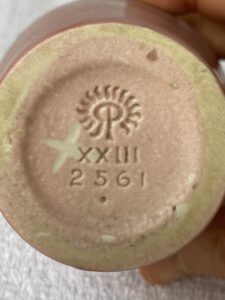
As shown in these examples, some Rookwood pieces have an “X” scored on the bottom. A cogent explanation of this marking is contained in Lucile Henzke, Art Pottery of America p.199 (1999):
[An] “X” scratched in the base . . . usually indicates the piece was a “second” and was not allowed to be sold at the top quality price, however, the “X” did not always indicate a “second.” The Rookwood management was constantly striving to increase business by attempting new methods of merchandising, however, despite all efforts, the salesroom became over stocked. In order to alleviate this problem, a certain amount of perfect pieces were removed and placed in the “seconds” room. These were incised with an “X” and reduced in price where they sold more readily. [Because] the “X” mark does not always mean a “second,” the collector should evaluate the article by close scrutiny.
Another author observed:
As any collector can attest, the judgment of secondary items over a period of years as represented by pieces of varying age appears rather whimsical. Many items so marked contain only flaws of a very minor nature. In contrast, items are known with kiln cracks of several inches or more, and are not marked seconds.
Edwin J. Kircher, Rookwood Pottery—An Explanation of Its Marks and Symbols, quoted in Peck, The Book of Rookwood Pottery p. 70. Peck further notes that “some first-quality pieces are found marked as seconds.” Id.; see also Anita J. Ellis, Rookwood Pottery: The Glorious Gamble (1992) at p. 86 (X marking “means that [the piece] was kept from the sales room,” sometimes because “an experiment with a glaze, a body, or a decoration produced such fine results that the piece was held back . . . for future reference”).
An X with a third intersecting line, referred to on this site as an “asterisk,” denotes a giveaway item.
An X marking generally reduces market value by at least 20%, even when there is no visible flaw. This points up the need to scrutinize photos in sale listings carefully, as sellers often fail to mention that the piece is X’d.
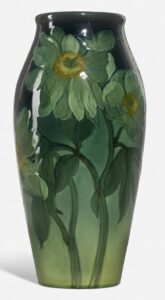
If a piece is rare and valuable enough, however, an X marking does not seem to impair market value at all, especially when sold by an auction house known to have deep expertise in Rookwood. For example, shape number 192Z(5), despite being X’d, brought $7,560 at auction in June 2023. See also shapes 614(5), 1664(7).
Some Rookwood pieces, especially those with glossy glazes such as Iris glaze, suffer from “crazing”–surface cracking that results from differing rates of shrinkage of glaze and ceramic in the cooling process. Crazing did not cause Rookwood pieces to be marked with an X. Rookwood Director William W. Taylor is quoted as stating, “In regard to the crazing we count it as nothing . . . as no pottery in the world can prevent it and obtain such colors.” (Anita J. Ellis, Rookwood Pottery: the Glaze Lines (1995), p.35.)
As to market value, however, David Rago stated, “Generally an uncrazed piece of Rookwood will bring an additional 25 percent and will be a lot easier to sell. Nevertheless, there are many, many fine pieces out there with crazing that are entirely too desirable for crazing to make much of a difference.” (Style 1900 magazine, Vol. 9 No. 2, Spring/Summer 1996, p.13.)
